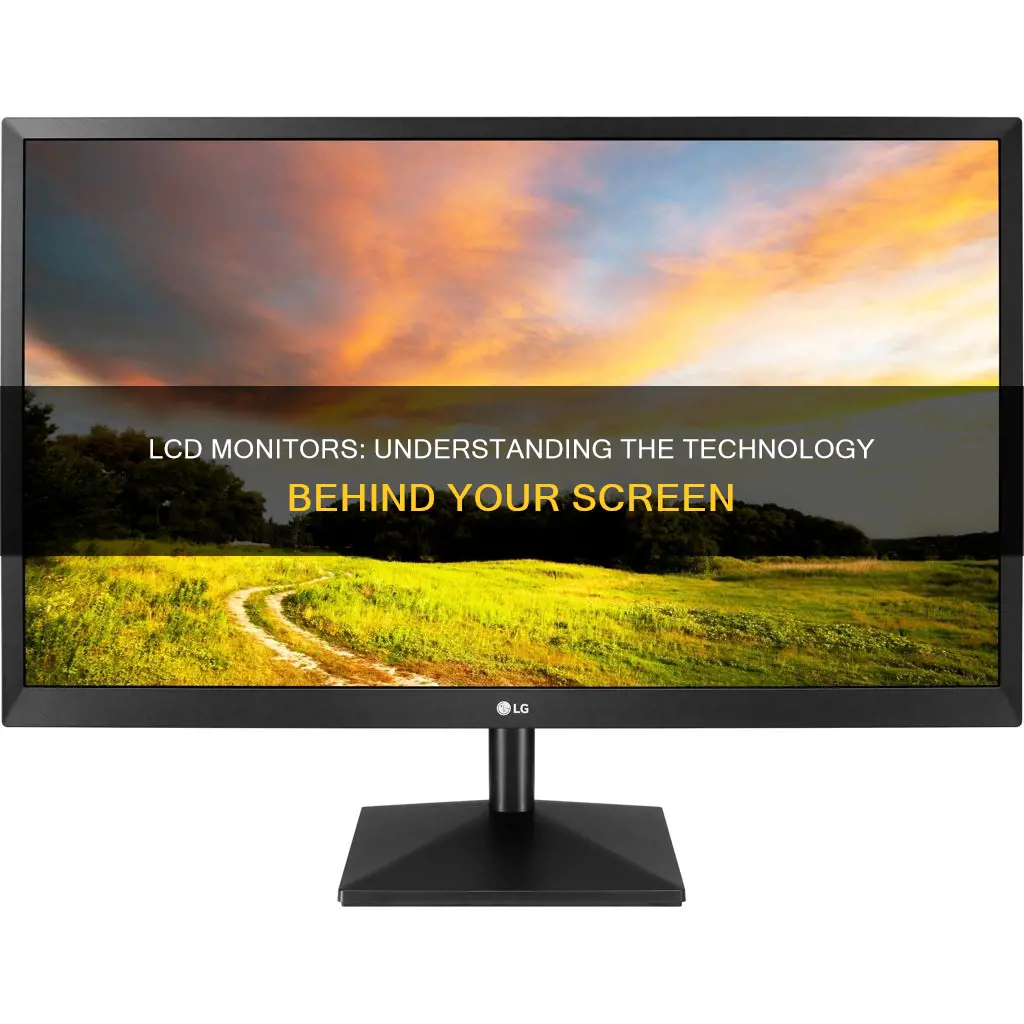
If you're wondering whether your monitor is an LCD, it's important to understand the difference between LED and LCD technology. LED (Light-Emitting Diode) and LCD (Liquid Crystal Display) refer to different aspects of monitor technology, specifically the backlighting and display. All LED monitors are LCD monitors, but not all LCD monitors are LEDs. LED monitors are a subtype of LCD that uses LED backlighting instead of fluorescent. LED-backlit LCD monitors offer advantages such as thinner designs, lower power consumption, and longer-lasting diodes, resulting in a more even illumination. However, they can be more expensive. On the other hand, LCD monitors with CCFL (Cold Cathode Fluorescent Light) backlighting tend to be cheaper and were more common in the past. To determine if your monitor is an LCD, check if it has an LED or CCFL backlight.
| Characteristics | Values |
|---|---|
| Definition | Liquid Crystal Display |
| Backlighting | LED or CCFL |
| Thickness | LED LCD monitors are thinner |
| Weight | LED LCD monitors are lighter |
| Power Usage | LED LCD monitors use less power |
| Lifespan | LED diodes have a longer lifespan |
| Image Quality | LED LCD monitors have superior image quality |
| Backlight Configuration | Full-array or edge lighting |
| Picture Quality | Full-array LED LCD monitors have better picture quality |
| Cost | LED LCD monitors are more expensive |
What You'll Learn

LED monitors are a subtype of LCD monitors
When it comes to monitors, the terms "LCD" and "LED" refer to different backlighting technologies used in the screens. All LED monitors are a type of LCD monitor, but not all LCD monitors are LEDs.
LCD stands for Liquid Crystal Display. LCD monitors use liquid crystals—substances with properties of both liquids and solids—to create images on a screen. When an electric current is applied, the liquid crystals align to allow or block light, forming the images you see. LCD monitors typically use cold cathode fluorescent lamps (CCFLs) for backlighting.
LED, or Light-Emitting Diode, monitors are a subtype of LCD monitors that use LEDs for backlighting instead of traditional fluorescent lights. This gives them some advantages over standard LCD monitors. LED monitors offer improved colour accuracy, visual clarity, and thinner designs. They are also more energy-efficient, resulting in lower power consumption and reduced electricity bills. Additionally, LED monitors often have a longer lifespan due to their more durable backlighting technology.
The use of LED backlighting in LCD monitors provides superior picture quality, especially in LED monitors with full-array backlighting. This type of backlighting allows for local dimming, resulting in better contrast and deeper blacks. However, LED monitors with edge lighting, where LEDs are placed along the edges of the screen, may have inferior picture quality compared to standard LCD monitors.
In summary, LED monitors are a subtype of LCD monitors that utilise LED backlighting to enhance image quality, energy efficiency, and lifespan.
Monitoring Data Usage: Xfinity Router Guide
You may want to see also

LCD stands for liquid crystal display
LCDs work by using the light-modulating properties of liquid crystals combined with polarizers to display information. Each pixel in an LCD screen typically consists of a layer of molecules aligned between two transparent electrodes and two polarizing filters. The liquid crystals do not emit light directly but instead use a backlight or reflector to produce images in color or monochrome. The backlight in an LCD provides an even light source behind the screen, and this light is polarized, meaning only half of the light shines through to the liquid crystal layer.
The liquid crystals in an LCD are made up of a part solid, part liquid substance that can be "twisted" by applying electrical voltage to them. They block the polarized light when they are off but reflect red, green, or blue light when activated. Each pixel has a red, green, and blue RGB sub-pixel that can be turned on or off. By adjusting the individual levels of red, green, and blue light, millions of color combinations are possible.
Modern LCDs typically use active-matrix technology, which contains thin-film transistors (TFTs). These transistors include capacitors that enable individual pixels to "actively" retain their charge, making active-matrix LCDs more efficient and responsive than passive-matrix displays.
Overclocking Your ASUS Monitor to 75Hz: A Step-by-Step Guide
You may want to see also

LED monitors use light-emitting diodes for backlights
LED monitors use light-emitting diodes (LEDs) for backlights, and are a subtype of LCD monitors. This means that all LED monitors are also LCD monitors, as they have an LCD panel. However, not all LCD monitors are LED monitors, as some use CCFL backlighting instead of LEDs.
The backlight is the part of the monitor that produces illumination. Even if a monitor is labelled as a "liquid-crystal display" (LCD), it likely still uses a backlight to produce illumination. In recent years, the use of LEDs for backlighting has become increasingly common.
LED backlights offer a range of advantages over other types of backlights. They are energy-efficient, consuming significantly less power than other types of backlights. This makes them a popular choice for devices that consume a lot of energy. Additionally, LED backlights are available in small sizes, with LEDs being as small as 2 mm. This allows manufacturers to create smaller display devices with a slimmer profile. LED backlights also tend to have a longer lifespan, and they produce less heat, reducing the risk of fires.
There are two main types of LED backlights: white and RGB. White LED backlights are commonly used in computer monitors and mobile devices. However, the term "white LED" is a bit misleading. Instead of producing white light, it produces blue light that is altered using yellow-coloured phosphor compounds. On the other hand, RGB LED backlights use an array of red, blue, and green LEDs. These are typically used in high-end display devices to achieve superior illumination.
Enhancing Acer LCD Monitor Brightness Settings
You may want to see also

LCD monitors use fluorescent backlights
LCD stands for Liquid Crystal Display. LCD monitors use cold cathode fluorescent lamps (CCFLs) for backlighting. The liquid crystals inside an LCD panel don't have any illumination of their own and require light to come from a separate component. This is where the fluorescent backlights come in.
The main difference between LCD and LED monitors lies in their backlighting technology. LED monitors use light-emitting diodes for backlighting, while LCD monitors use fluorescent backlights. It's important to note that all LED monitors are a type of LCD monitor. The term "LED monitor" is shorthand for "LED-backlit LCD monitor".
LCD monitors with fluorescent backlights have several advantages. They are typically thinner and more energy-efficient than older CRT monitors. They also offer good colour reproduction and brightness. Additionally, LCD monitors are generally less expensive than LED monitors.
However, there are some trade-offs. LCD displays may struggle with producing true blacks, and their picture quality may not be as superior as LED displays. Nevertheless, LCD monitors are a common choice for traditional computing and can be suitable for gaming with the right specifications.
Monitors for Stock Trading: Size and Display Quality Matters
You may want to see also

LED monitors are thinner, lighter, and use less power than LCD monitors
LED monitors are a subtype of LCD monitors that use LED backlighting. This means that all LED monitors are technically a type of LCD monitor, but not all LCD monitors use LED backlighting.
LCD stands for Liquid Crystal Display. This technology uses liquid crystals, which have properties of both liquids and solids, to create images on a screen. When an electric current is applied, the liquid crystals align to either allow or block light, thus creating the images we see on the display. LCD monitors typically use cold cathode fluorescent lamps (CCFLs) for backlighting.
On the other hand, LED stands for Light-Emitting Diode. LED monitors use light-emitting diodes for backlighting instead of traditional fluorescent lights. This makes LED monitors thinner, lighter, and more energy-efficient than standard LCD monitors. LED backlights typically last 50,000 to 100,000 hours, while CCFL backlights in LCDs last only 30,000 to 60,000 hours. This longer lifespan makes LED monitors more cost-effective in the long run, despite their higher initial price.
LED monitors also offer better contrast ratios, improved colour accuracy, and faster response times compared to LCD monitors. The faster response times make LED monitors ideal for gaming, as they reduce motion blur and ghosting. Additionally, the superior colour accuracy and contrast ratios of LED monitors make them a preferred choice for graphic design, photo editing, and video production professionals.
In summary, LED monitors offer several advantages over standard LCD monitors, including reduced thickness and weight, improved energy efficiency, longer lifespan, and enhanced display quality. These benefits make LED monitors a popular choice for both general consumers and professionals, despite their higher upfront cost.
Setting Up Audio on Your ASUS Monitor
You may want to see also
Frequently asked questions
All LED monitors are LCD monitors, but not all LCD monitors are LEDs. If your monitor uses cold cathode fluorescent lamps (CCFL) for backlighting, it is an LCD monitor.
LCD monitors use CCFL backlights, whereas LED monitors use light-emitting diodes (LEDs) for backlighting. LED monitors usually have superior picture quality and are thinner, lighter, and more energy-efficient than LCD monitors.
LCD monitors are generally cheaper than LED monitors.







